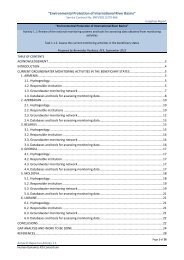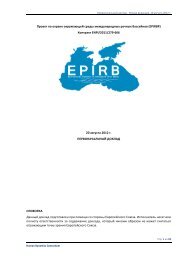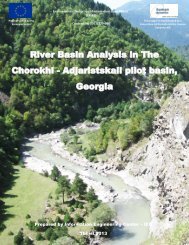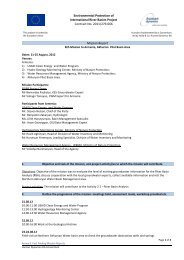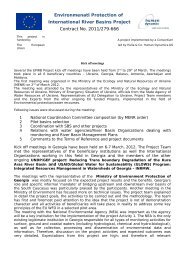Nokia Standard Document Template - Environmental Protection of ...
Nokia Standard Document Template - Environmental Protection of ...
Nokia Standard Document Template - Environmental Protection of ...
- No tags were found...
You also want an ePaper? Increase the reach of your titles
YUMPU automatically turns print PDFs into web optimized ePapers that Google loves.
4th Mission Report _KE3_Jan –Feb 2013i) The GLC column is DN- 5, 25mX 0.32mmX0.24µ manufactured by DANI (Italian Co.), which isrecommended for EPA method 608/808, however the ISO 6468 method was being used instead. To assistin identifying the peaks it was recommended to obtain this EPA method.ii) The Department had obtained a new calibration standard <strong>of</strong> 17 components but this had not been usedas the staff are waiting for a special “certan” vial to be delivered in order to store this standard correctly.iii) Initially, the results from the chromatograms and were not clear, but following further investigations <strong>of</strong>the s<strong>of</strong>tware, the results were clarified. It was recommended that a SOP is produced to clarify theprocedures.iv) The extraction efficiency had been determined for each <strong>of</strong> the five pesticides, however this couldchange depending on the water sample characteristics, therefore it was recommended that an internalcalibration standard is used.v) The current sample bottles were HDPP plastic bottles, however, according to the method, these werenot acceptable. It was recommended that these be replaced by 2l amber glass bottles with ground glassstoppers or caps with Teflon inserts.vi) The GLC was not being used at the time, as the high purity nitrogen had been depleted and theDepartment was waiting for new cylinders to be delivered. The Department tried to use another source <strong>of</strong>nitrogen, but this was not pure enough. It was recommended to keep a reserve cylinder in stock, and alsoinstall carbon filters inline from the gas cylinder to the GLC to prevent gross contamination.The current staff were relatively new on GLC analyses (6 months) and the training and interfacing <strong>of</strong> theequipment was undertaken by Vakhtan g Ugrekhelidze, GLC expert (Georgian Isotopic Institute). It wasrecommended that he should be further engaged to assist in the above recommendations.2) Analytical Quality ControlThe Laboratory participates in a number <strong>of</strong> external quality control schemes, e.g. Accreditation Institute<strong>of</strong> Slovakia (SNAS) scheme and had been ranked highly in them which is a good quality control indicator.In addition the laboratory analyses 7 parameters (F, CL, NO2, Br, NO3, PO4, SO4), which includeinternal AQCs to produce Shewhart charts, using independent s<strong>of</strong>tware. However, internal AQCs were stillrequired for about thirty other parameters. Elina Bakradze was previously responsible for quality controlbut had recently been promoted and this work was transferred to Ms. Gulchina Kuchava, who wascurrently learning these techniques. Elina has written all the procedures Quality Manual, SOP, SP, GP, etc.which are necessary for the ISO 17025 and has provided the training for Gulchina Kuchava on qualitymanual and now the laboratory are progressing the implementation <strong>of</strong> those procedures. Therefore thetraining submitted during this mission should have proved very useful as a support for this.Recently the certified experts from the “ICI project –Capacity Building on the Water Monitoring andManagement in Georgia, 2011-2013 (Georgia Waters) visited the NEA laboratory and have made anauditi on 3 components viz. , Ion Chromatography analyses and Microbiology. They maderecommendations in March 2013, which have now been implemented. They have concluded that all isnow perfect apart from an amendment on purchasing new reagents.)The KE3 presented a local training workshop on quality control 4th February for 7 staff, and the rest <strong>of</strong> thepertinent staff attended the more comprehensive Regional Training Seminar on 5th February. In addition,the KE3 submitted a separate training on the UK method validation s<strong>of</strong>tware to Elina Bakradze.Unfortunately the s<strong>of</strong>tware was unable to function correctly on the laboratory’s computers, though it hadPage 11 <strong>of</strong> 36




